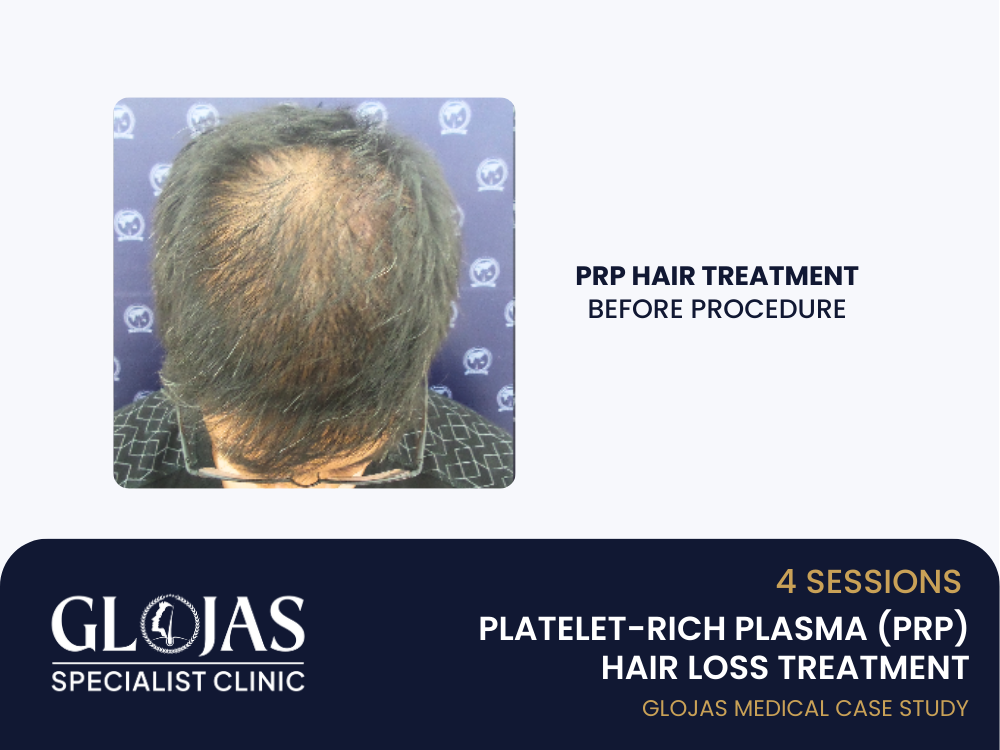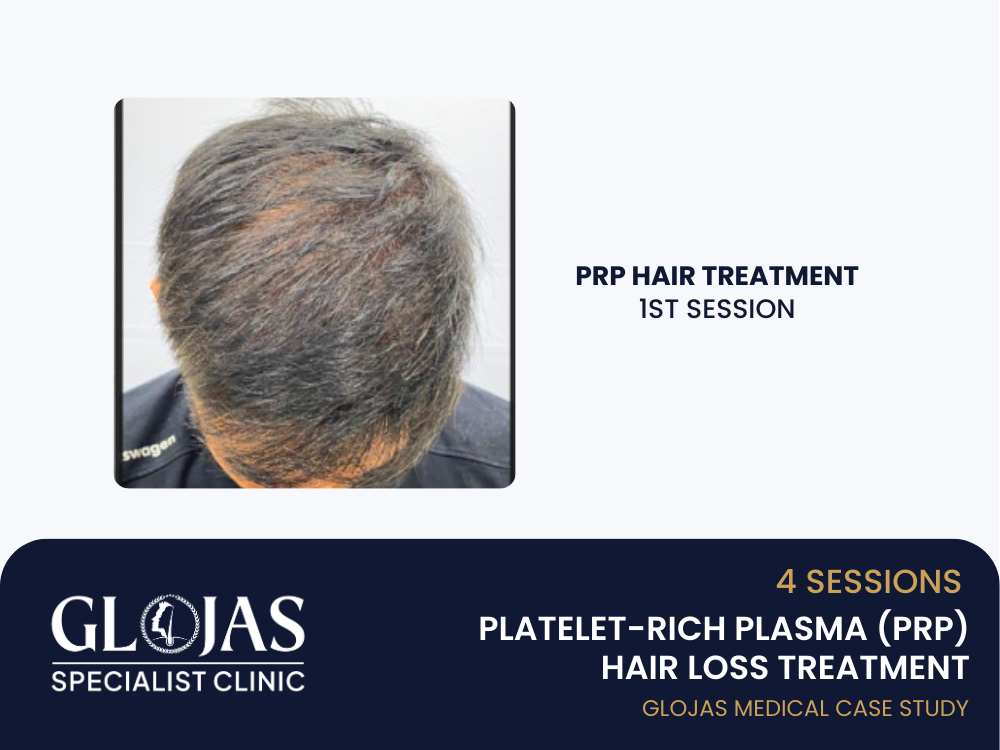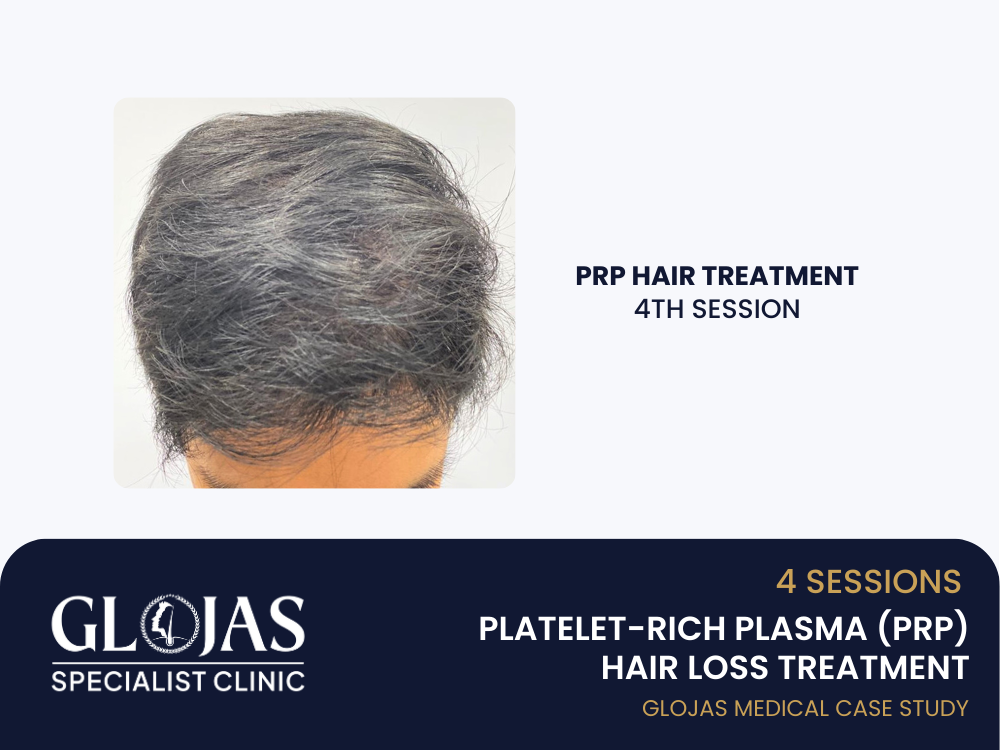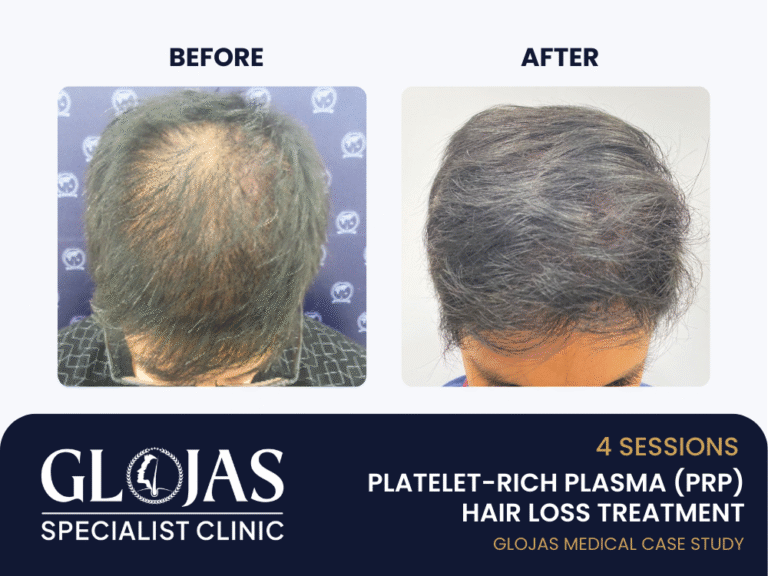Hair thinning is a frustrating condition that affects both men and women. While it’s often seen as a natural part of aging, the emotional impact of losing volume, density, and scalp coverage can be significant.
This case study features a 32-year-old male who underwent 4 PRP hair loss treatment (Platelet-Rich Plasma) therapy sessions to treat progressive hair thinning, with visible improvements by the end of the fourth session.
Patient Background
Name: Mr. J (name anonymized)
Age: 32
Gender: Male
Hair Concern: Generalized thinning on crown and mid-scalp
Diagnosis: Early androgenetic alopecia (Norwood II)
Hair Type: Fine, straight
Previous Treatments: Over-the-counter shampoos, no medications
About a year ago, Mr. J started noticing increased hair fall and reduced hair density around the crown. Although not yet bald, the diffuse thinning was becoming harder to ignore.
Why Choose PRP Hair Loss Treatment Therapy?
PRP (Platelet-Rich Plasma) therapy is a non-surgical, autologous treatment that uses the patient’s own blood plasma, rich in growth factors, to stimulate hair follicles, improve blood circulation, and encourage natural hair regrowth.
Benefits of PRP:
Safe and minimally invasive
Uses the body’s own healing properties
Stimulates dormant follicles
Improves the thickness and quality of hair
No downtime and low risk of side effects
PRP was recommended as the first-line treatment before exploring more invasive options.
Treatment Plan

Mr. J was scheduled for 4 sessions over 4 months, spaced every 3–4 weeks.
Session Protocol:
15 ml of blood was drawn from the patient
Centrifugation to extract platelet-rich plasma
Scalp cleansing and numbing
Microinjections of PRP into the thinning areas (crown and mid-scalp)
Post-injection scalp massage to enhance absorption
Observations After Each Session

📍 Session 1:
Slight tenderness post-injection
No immediate change (normal)
📍 Session 2:
Less daily hair fall
Scalp looked healthier
No adverse effects
📍 Session 3:
Early regrowth was observed in the crown area
Hair felt thicker and easier to style
📍 Session 4:
Noticeable increase in density
Reduced scalp visibility
More even texture and improved volume
Results After 4 Sessions

At the final follow-up (end of Month 4), Mr. J experienced:
| Area | Before PRP | After 4 Sessions |
|---|---|---|
| Crown | Visible scalp, thinning hair | Scalp coverage improved ~40–50% |
| Mid-scalp | Fine hair, lacking volume | Thicker strands, fuller appearance |
| Hair fall | ~100 strands/day | Reduced to ~30–40 strands/day |
| Confidence | Hesitant, avoided styling | Increased – changed hairstyle |
No side effects were reported, and patient satisfaction was high.
What Made This Case Successful?
✅ Early intervention before advanced hair loss
✅ Consistent attendance and aftercare compliance
✅ Good scalp condition with active follicles
✅ Realistic expectations
The result wasn’t a full transformation like a hair transplant but rather a recovery of density and quality, which is exactly what PRP is designed for.
Post-Treatment Maintenance
Mr. J was advised to:
Return for a booster session every 6 months
Continue with DHT-blocking shampoo
Avoid stress and support scalp health with a balanced diet
He plans to continue PRP maintenance for long-term hair preservation.
5 Frequently Asked Questions (FAQ)
1. How many PRP sessions are needed to see results?
Most patients notice improvement after 3–4 sessions, though some may require 6 or more, depending on severity and response.
2. Is PRP a cure for baldness?
No—PRP works best for thinning hair and early-stage hair loss. It may not regrow hair on fully bald patches with no active follicles.
3. Are PRP results permanent?
PRP slows hair loss and improves density, but maintenance sessions every 4–6 months are often needed for lasting results.
4. Does PRP therapy hurt?
Small needle injections cause only minimal discomfort. For patient comfort, numbing cream or local anesthesia is applied.
5. Can women also do PRP?
✅ Yes. PRP is effective and safe for both men and women, especially those with diffuse hair thinning or post-partum hair loss.
Final Thoughts
This case highlights the power of early, consistent intervention with PRP therapy in managing hair thinning. With just 4 sessions, Mr. J regained thicker hair and renewed confidence.
While PRP is not a miracle fix for all types of hair loss, it is an excellent non-surgical solution for those experiencing diffuse thinning, mild androgenetic alopecia, or post-shedding recovery.
If you’re noticing more hair in your brush or your scalp becoming more visible, PRP could be your first step toward healthier, fuller hair, naturally.
